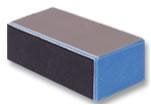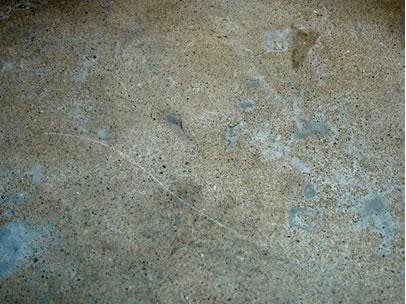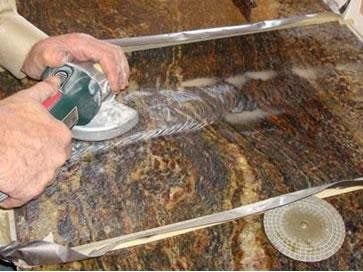- Countertop Supplies Home
- Concrete Countertop Molds
- Concrete Countertop Mix
- Pigments & Custom Options: Color additives, special effects & decorative add-ins
- Countertop Reinforcement
- Casting Equipment: Tables, mixers, vibrators & curing covers
- Countertop Finishing & Installation
- How to Polish Concrete Countertops
- Sealers for Concrete Countertops
- Delivery and Installation
- Related Reading
- Problems with Concrete Countertops
- Countertop Product Reviews
- Concrete Countertop Basics: Pricing, colors, edge details, and more
How to Remove Scratches from Concrete Countertops
Tips for touching up minor surface scratches and fixing scratches in topical sealersIf you have scratches on your concrete countertops, these expert Q&As can help you fix them.
Need help with scratches?
Find concrete countertop contractors near me
TOUCHING UP MINOR SURFACE SCRATCHES
Question:What's the best way to touch up minor scratches in the surface of my concrete countertop? Is this something I can do myself, or should I hire a professional?
Answer:Because the scratches are minor, they are most likely in the countertop sealer and not in the concrete itself. Just like with scratches in a car door, there are two approaches to fixing them. One is to simply touch up the scratch with more sealer, and the other is to reseal the whole slab.
Touching up the finish will restore the protection and reduce the appearance of the scratch. But depending upon the degree of care used and the size, location, and depth of the scratch, the touchup repair might be more visually objectionable than the scratch itself. This is usually something a homeowner can do, but ask your contractor for good instructions and some sealer you can easily use and apply. You don't want to use a two-part sealer that must be mixed and sprayed onto the countertops with special equipment. Your "touchup kit" should be simple, almost like the touchup kit used for cars.
Generally a single-component sealer, such as an acrylic, is used for scratch touchup. A very fine artist's brush and a steady hand are what it takes to apply just the right amount of finish to fill in the scratch. Often the excess sealer that builds up around the scratch is what looks bad. It's best to remove the excess with a paper towel, a dry brush, or a cotton swab while the sealer is still wet.
A "spotter" brush is the ideal type of application tool to use because it's very fine and doesn't hold much sealer. The bristles are short, and the small amount of sealer they hold won't squeeze out. Round brushes have fine points and are the most common type you'll find in arts-and-crafts stores. But round brushes can hold too much material and make it difficult to create a fine line. Liner brushes are often used for pin striping and lettering, where long flowing strokes are needed. They have long bristles and a fine point, but uneven pressure will cause the bristles to flare out, creating a wider line of sealer.
The ultra-mini spotter (shown here) has a very tiny brush. The size 20/0 indicates that it's very small. A size 3/0 is larger, and a 2 is even larger (roughly 2 millimeters in diameter).
Once the touchup is dry, you can then adjust the sheen to match the surrounding finish. If there is excess material in the touchup, first use a razor to carefully scrape off only the excess. It's better, though, to use a little less sealer and not have any excess. Any scratches to the surrounding finish will make the repair more apparent. Blending the repair into the rest of the countertop often involves precise sanding with fine-grade sandpaper. Specialty nail buffing pads for manicures are great tools for carefully buffing, smoothing, and polishing the touchup. Nail files are coarser and good for removing material.
HOW TO FIX SCRATCHES IN TOPICAL SEALERS
Question:A client called with concerns about scratches in the sealer of their concrete countertop. How do I repair them? Can I make them disappear?
Answer:Fixing scratches in topical sealers involves restoring both the appearance of the finished surface and the level of protection the undamaged sealer provided. There are two basic methods for repairing the surface:
-
Mechanical abrasion, either by buffing or by polishing the scratch out of the surface.
-
Filling in the scratch and blending its appearance with the surrounding surface.
A topical sealer on concrete, however, is very thin and it's easy to sand through the finish if you're not careful. Typical coatings are on the order of 2 to 5 mils (thousandths of an inch) thick. For reference, a piece of copy paper is usually 4 mils thick, so the finish that protects your concrete is literally paper thin.
It's usually not possible to sand and buff out deep scratches in topical sealers, but minor scuffs and shallow scratches can be buffed out. This approach can be used only if the scratch is very shallow, and it only looks good if the final appearance of the sanded/buffed area matches the original finish that surrounds the repaired area. Mild abrasive compounds and a wool buffing bonnet are common means of buffing out scratches.
The easiest way to hide minor scuff marks is with wax. Applying wax to the surface helps hide minor scratches and scuffs by filling in the scratch. But this is just a temporary fix since wax wears off over time as the countertops get cleaned.
A more permanent method for fixing scratches is to fill them in with a material that restores the appearance and protection of the undamaged surface. Simply applying more sealer to the scratch will restore the protection, but unless care is exercised, the repair may be quite apparent and visually unacceptable. In fact, it may even look worse than the scratch. The greatest challenge with topical sealers is to restore the appearance to like-new condition without having to reseal the whole countertop.
The first step to repairing a scratch by filling it in with sealer is to clean and prepare the surface. Knowing what was used to seal the concrete and understanding how that sealer behaves is helpful. Different sealers can require different techniques, but most of the differences have to do with surface preparation and appearance restoration.
Surface preparation should always include cleaning to remove dirt, oil, and other contaminants. It's especially important to remove wax, oil, grease, and any other material that would inhibit a good bond between the new sealer and the existing surface. Mild detergents such as dish soap, window cleaner, and other household spray cleaners work on nearly all finishes. Some finishes can be degreased with acetone, which cleans and dries the surface.
Solvent-based acrylics will soften and dissolve when more solvent-based acrylic sealer (or just straight solvent like acetone) is applied. The new sealer melts back into the old sealer, and careful sanding and buffing can remove any excess to restore the surface profile and make a smooth finish. Light scuffs and shallow scratches can be removed or diminished by wiping the surface with a solvent-soaked cloth. The solvent dissolves the sealer and smoothes the surface, partially filling and partially smoothing the scratch. This technique works on many water-based acrylic finishes too.
This method for scuff removal can't be used with urethane or epoxy sealers. No amount of solvent will soften the finish, and some harsh solvents may even damage it. Because they are catalyzed finishes, urethanes and epoxies will not resoften. That's the property of these finishes that tends to make them perform so well. Reapplication usually requires roughening up the surface with fine sandpaper or steel wool so that the new sealer will mechanically bond to the cured sealer.
Urethane and epoxy finishes can be touched up with more urethane (or epoxy), but more often a simple acrylic sealer is used. It dries fast, doesn't need mixing (which is tough to do with the tiny amount of sealer needed), and sticks well to many different topical sealers. However, I would recommend using the same sealer that was originally used if the scratch penetrates to the bare concrete. This will restore the countertop's stain protection.
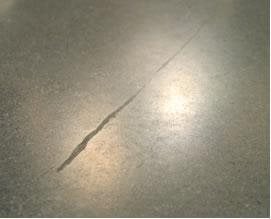
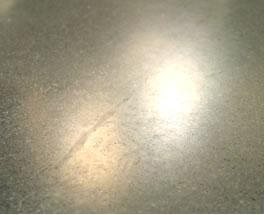
A filled-in scratch ready to be blended (left) and after blending (right). While it's still apparent in the glare of bright lights, the repair is invisible under normal lighting.
Finally, the ultimate repair is resealing the concrete, either the entire countertop or the slab (seam to seam). This is similar to taking your car to a repair shop. The damaged door is completely repainted and looks like new again. It's a radical step, but it may be the best solution for a countertop covered in scratches.
Just as with sealing, learning how to repair a scratch requires practice. Don't expect the first scratch you fix to look good, so hone your skills in the shop before repairing a scratch for a client.
Return to Fixing Concrete Countertops
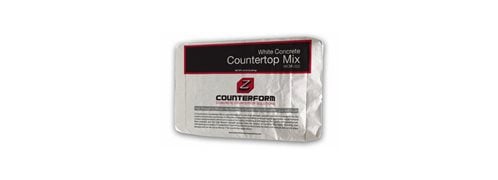 White Countertop Mix
Pre-blended, all in one, high strength castable concrete mix.
White Countertop Mix
Pre-blended, all in one, high strength castable concrete mix.
 SS EZ Top Resurfacing Kit
Apply over laminate, solid surface, and tile countertop surfaces.
SS EZ Top Resurfacing Kit
Apply over laminate, solid surface, and tile countertop surfaces.
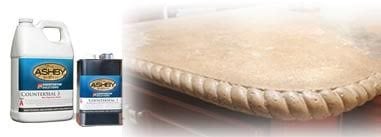 Topcoat Sealer
Produces a scratch and stain resistant top coating.
Topcoat Sealer
Produces a scratch and stain resistant top coating.
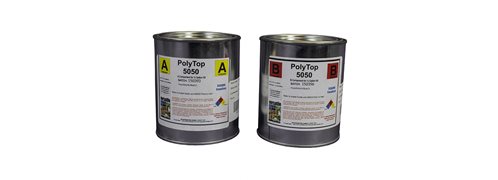 PolyTop Sealer
Designed for speed and heat resistance.
PolyTop Sealer
Designed for speed and heat resistance.
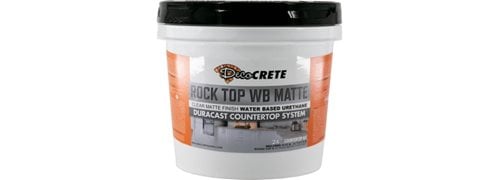 Rock Top Sealer
Clear matte finish, water-based urethane
Rock Top Sealer
Clear matte finish, water-based urethane
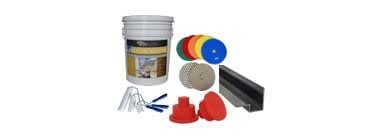 Countertop Products
All the supplies needed for great countertops.
Countertop Products
All the supplies needed for great countertops.
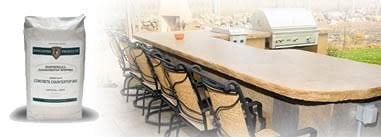 Imperial Countertop Mix
Engineered to be lightweight and strong. Minimal shrinkage.
Imperial Countertop Mix
Engineered to be lightweight and strong. Minimal shrinkage.
 Professional Grade Counter Mix
Easy finish, minimal shrinkage & exceptional strength
Professional Grade Counter Mix
Easy finish, minimal shrinkage & exceptional strength
